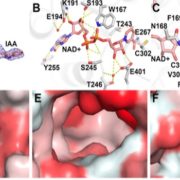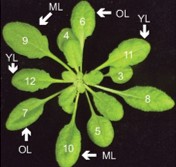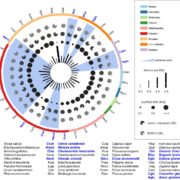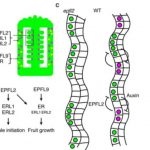The ectomycorrhizal fungus Laccaria bicolor produces lipochitooligosaccharides and uses the common symbiosis pathway ($) (Plant Cell)
 Nutrient exchange during plant-fungal symbiosis allows assimilation of nutrients necessary for plant growth in a beneficial way. Several plants have evolved to form symbioses with mycorrhizal fungi and rhizobia bacteria that allow the plants to efficiently take up nitrogen and phosphorous. In its interactions with mycorrhizal fungi, the plant secretes strigolactones (hormones) that are perceived by the fungus, which in return secretes lipochitooligosaccharides (LCOs). Exchange of these signals triggers a signaling cascade in plants that allows symbiosis to succeed. Previous studies have identified a common symbiosis pathway that is required for the interaction between plants and arbuscular mycorrhizal fungi or rhizobia bacteria. Cope et al. have demonstrated the conservation of the common symbiosis pathway in the interaction between the model woody plant, Populus and the ectomycorrhizal fungi, Laccaria bicolor. Using a genetic approach they showed the involvement of key conserved plant genes. Using mass-spectrometry approaches, the authors have identified the potential LCOs secreted by the fungal partner. Host phenotypic changes, such as root hair response and molecular changes occurring during symbiosis, demonstrate that a plant-ectomycorrhizal relationship has been established. (Summary by Suresh Damodaran) Plant Cell 10.1105/tpc.18.00676
Nutrient exchange during plant-fungal symbiosis allows assimilation of nutrients necessary for plant growth in a beneficial way. Several plants have evolved to form symbioses with mycorrhizal fungi and rhizobia bacteria that allow the plants to efficiently take up nitrogen and phosphorous. In its interactions with mycorrhizal fungi, the plant secretes strigolactones (hormones) that are perceived by the fungus, which in return secretes lipochitooligosaccharides (LCOs). Exchange of these signals triggers a signaling cascade in plants that allows symbiosis to succeed. Previous studies have identified a common symbiosis pathway that is required for the interaction between plants and arbuscular mycorrhizal fungi or rhizobia bacteria. Cope et al. have demonstrated the conservation of the common symbiosis pathway in the interaction between the model woody plant, Populus and the ectomycorrhizal fungi, Laccaria bicolor. Using a genetic approach they showed the involvement of key conserved plant genes. Using mass-spectrometry approaches, the authors have identified the potential LCOs secreted by the fungal partner. Host phenotypic changes, such as root hair response and molecular changes occurring during symbiosis, demonstrate that a plant-ectomycorrhizal relationship has been established. (Summary by Suresh Damodaran) Plant Cell 10.1105/tpc.18.00676









